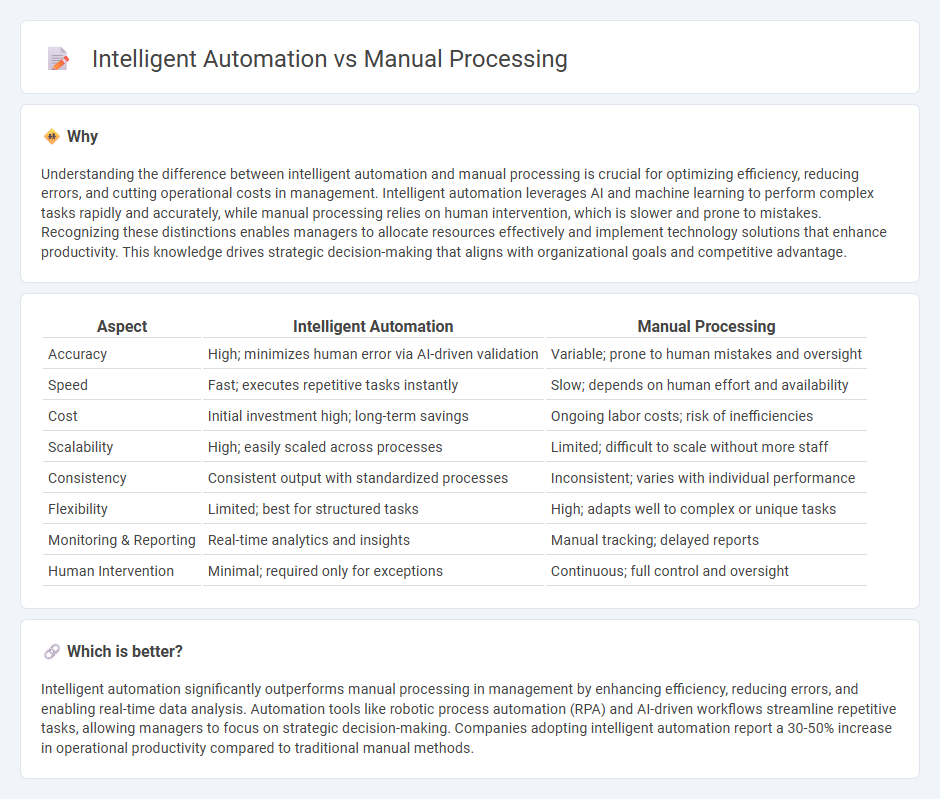
Intelligent automation enhances management by streamlining repetitive tasks through AI and machine learning, significantly reducing human error and operational costs compared to manual processing. Manual processes often involve time-consuming, error-prone activities that limit scalability and efficiency in business operations. Discover how intelligent automation transforms management workflows and boosts productivity.
Why it is important
Understanding the difference between intelligent automation and manual processing is crucial for optimizing efficiency, reducing errors, and cutting operational costs in management. Intelligent automation leverages AI and machine learning to perform complex tasks rapidly and accurately, while manual processing relies on human intervention, which is slower and prone to mistakes. Recognizing these distinctions enables managers to allocate resources effectively and implement technology solutions that enhance productivity. This knowledge drives strategic decision-making that aligns with organizational goals and competitive advantage.
Comparison Table
| Aspect | Intelligent Automation | Manual Processing |
|---|---|---|
| Accuracy | High; minimizes human error via AI-driven validation | Variable; prone to human mistakes and oversight |
| Speed | Fast; executes repetitive tasks instantly | Slow; depends on human effort and availability |
| Cost | Initial investment high; long-term savings | Ongoing labor costs; risk of inefficiencies |
| Scalability | High; easily scaled across processes | Limited; difficult to scale without more staff |
| Consistency | Consistent output with standardized processes | Inconsistent; varies with individual performance |
| Flexibility | Limited; best for structured tasks | High; adapts well to complex or unique tasks |
| Monitoring & Reporting | Real-time analytics and insights | Manual tracking; delayed reports |
| Human Intervention | Minimal; required only for exceptions | Continuous; full control and oversight |
Which is better?
Intelligent automation significantly outperforms manual processing in management by enhancing efficiency, reducing errors, and enabling real-time data analysis. Automation tools like robotic process automation (RPA) and AI-driven workflows streamline repetitive tasks, allowing managers to focus on strategic decision-making. Companies adopting intelligent automation report a 30-50% increase in operational productivity compared to traditional manual methods.
Connection
Intelligent automation integrates with manual processing by streamlining repetitive tasks while allowing human intervention in complex decision-making areas, enhancing operational efficiency and accuracy. Data-driven algorithms in intelligent automation analyze patterns from manual inputs, enabling adaptive workflows that improve over time. This synergy reduces errors, accelerates processes, and maximizes resource utilization within management systems.
Key Terms
Efficiency
Manual processing relies heavily on human intervention, often leading to slower cycle times and increased error rates, which reduce overall operational efficiency. Intelligent automation integrates AI and machine learning to streamline workflows, minimize errors, and accelerate task completion, significantly boosting productivity. Explore how transitioning to intelligent automation can transform your efficiency metrics and drive better business outcomes.
Error Reduction
Manual processing often leads to higher error rates due to human fatigue and inconsistency in repetitive tasks, while intelligent automation leverages machine learning algorithms and robotic process automation (RPA) to enhance accuracy and minimize errors. Intelligent automation can detect anomalies and adapt workflows in real time, significantly reducing operational risks and improving data integrity. Explore how implementing intelligent automation can transform your error reduction strategies and boost efficiency.
Scalability
Manual processing relies heavily on human intervention, limiting scalability due to increased labor costs and slower throughput when handling larger volumes of data. Intelligent automation leverages AI, machine learning, and robotic process automation (RPA) to rapidly scale operations, reduce errors, and improve efficiency across complex workflows. Explore how intelligent automation can transform your business by driving scalable growth and operational excellence.
Source and External Links
Manual Processing Definition - Manual processing means authorizing transactions manually, without electronic confirmation, often used as a backup during system failures.
Manual Process vs Automated Process: A Comparison Guide - A manual process involves human-performed tasks, such as data entry, and is generally more time-consuming and prone to errors than automated alternatives.
Manual Process vs Automated Process | Choose A Better ... - In a manual process, people rely on their own skills and experience to complete tasks without modern technology, often resulting in slower but potentially more personalized outcomes.
 dowidth.com
dowidth.com